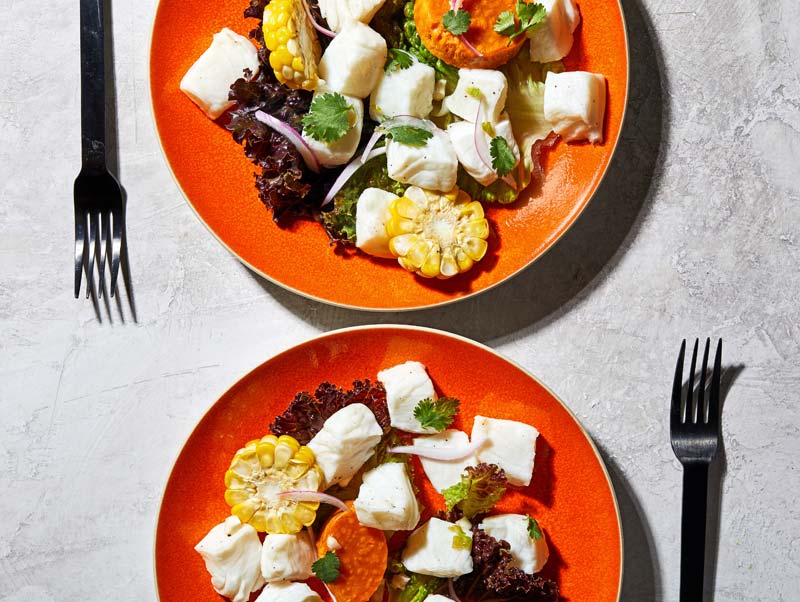 Stacy Zarin Goldberg for The Washington Post
Stacy Zarin Goldberg for The Washington Post
Raw fish is a hard sell for some people, and I'll admit it had been for me at one point. That aversion can be a turnoff when it comes to something like sushi. Ceviche, however, is a good intermediate step for the raw fish skeptic, because of its preparation.
Like its Japanese cousin, this South American specialty consists of unheated seafood that is allowed to shine. I say unheated, because it is essentially "cooked," if you want to call it that, in citrus juice (more on that below). Also like sushi, it can be an elegant, relatively easy dish to prepare.
Here's what you need to know:
• What it is
Where the practice of curing fish in citrus juice began is not exactly clear --- in addition to Latin America, some historians look to Spain, Asia and the Philippines, according to chef Maricel Presilla in her comprehensive 2012 book, "Gran Cocina Latina." It is now a signature dish in Latin America, especially associated with Peru, which Carlos Delgado (a Peruvian native, naturally), chef at China Chilcano in Washington, endorses as the OG home.
How is the dish cooked yet uncooked? The citrus juice -- bitter orange originally, most often lime these days -- firms up the fish from the outside in. This process alters the structure of the proteins, transforming the flesh from transparent to more opaque.
• Use the freshest fish
"I tell people it's all about what you like," Delgado says about picking a fish for ceviche. His menu at China Chilcano includes variations with tuna and salmon, among others. He says you can make ceviche out of almost any fish, though he says he doesn't think the flavor of tilapia is ideal for it. Presilla suggests a firm-fleshed fish that will not fall apart in the acid of the citrus juice. You can go for something oily (mackerel or smelt) or white-fleshed. Among her favorites are halibut, flounder and sole.
No matter which fish you choose, make sure it's very, very fresh. Ask lots of questions: Where did it come from? When did it arrive? Is it in season? As far as safety goes, the FDA recommends that seafood intended to be eaten raw should previously have been frozen to eliminate parasites that the fish may have ingested in its feed. Fiona Lewis, owner of District Fishwife in Washington, says wild salmon should not be eaten raw because of that risk. In general, she says, using high-quality farmed fish where the feed can be confirmed parasite-free is one way to reduce the probability of exposure.
It's also important to keep the fish as cold as you can before you use it (which should be not long after you buy it).
• Don't let it cure too long
Marinating meat for long periods of time is not necessarily beneficial, and the same is certainly true about ceviche fish. We're talking about marinating for a matter of minutes, after which the fish should be eaten immediately. Too much time in the acid will cause the fish to turn mushy and fall apart.
Delgado suggests 5 to 10 minutes, although J. Kenji Lopez-Alt at Serious Eats pushes the window up to about 30 minutes max. Marinating times vary depending on how you have cut the fish - thinly sliced, chopped into small pieces or divided into large chunks. You'll know the fish is ready when it has just lost its translucency.
You also want to make sure the citrus juice barely covers the fish. "It's not a soup," Delgado says. Turn the fish a few times for even coverage.
If you would like to give yourself a bit of a cushion and cut down on the sharpness of the lime juice, you can add a few ice cubes, removing them before they melt, Presilla recommends.
• Don't overwhelm the fish
Have you ever seen someone grimace when they witness a beautiful piece of sushi cloaked in wasabi? Same idea here. You want to respect the fish, Delgado says. A little soy sauce or ginger in the marinade or in the final presentation is okay, but be judicious.
You can also add flavor by adding ingredients to the lime juice, such as sliced onion, crushed or minced garlic, cilantro and/or a halved, seeded hot pepper.
Traditional elements that can be combined with the fish after it is cured are leche de tigre (tiger's milk) and an aromatic fish broth.
• Garnishes
"Peruvians tend to be the most minimalist as far as ceviche goes," Delgado says. A typical preparation might include red onion, fresh and dried corn, and cooked sweet potato. Delgado also favors items with crunch: jicama, onion, radish and hearts of palm. Another option in the opposite direction: charred avocado. Around Lima, you can find people topping their ceviche with beans, the chef says
Delgado says a fun idea is to throw a ceviche party, along the lines of a taco party. Let guests top their own bowls. (In the restaurant, appetizer portions of fish are about 3 ounces, but that's pretty generous.) You can even serve rice along with the ceviche, which is common around Lima.
As long as you treat the fish well, Delgado says what is most important is that you enjoy what you have made. So get creative.
"The sky's the limit," he says.


 Contact The Editor
Contact The Editor
 Articles By This Author
Articles By This Author